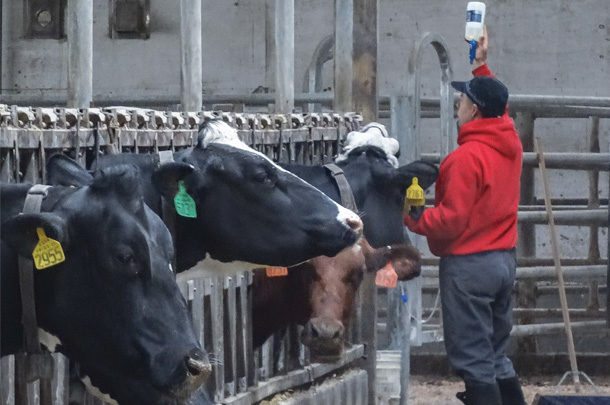A smooth transition is necessary for successful lactation. Managers need to evaluate all components of their transition cow program to identify successes or where improvements are needed. A daily check of data can alert managers of an emerging problem.
An evaluation of longer-term trends can help managers understand how well the transition program is working in general. To troubleshoot apparent problems in the fresh pen, start by looking at the cows, their housing, and the feedbunk.
What are the cows telling us?
Several options exist for checking on the physical health status of fresh cows, starting with deciding on how to house fresh cows. Housing options are many and include a dedicated fresh cow pen (ideal from the cow’s standpoint), a comingled pen with both fresh and treated or special needs cows (less ideal), and some fresh cows are released into the herd as soon as colostrum is collected and milk is cleared of any antibiotic residue.
How you plan to evaluate the health status of the fresh herd will help determine which housing strategy you use. Regardless of how these cows are grouped, a regular review of health monitoring practices can help avoid costly mistakes. Fresh cow managers need to strike the right balance between collecting enough health information and giving the cows free time to eat, drink, and sleep.
Cows identified as “at risk” through the screening protocol should receive a careful physical exam to identify any problems and begin treatment if warranted. Screening and physical exam errors can lead to sick animals getting overlooked or inappropriately treated. Errors in record keeping result in inaccurate data, making oversight difficult.
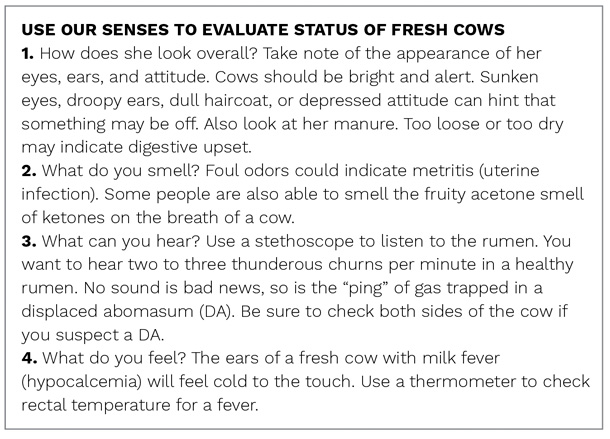
A few recent advancements in fresh cow health screening have been made. We used to rely heavily on urine ketosis strips to find cows with this metabolic condition. These diagnostic aids still have a place in fresh cow management, but digital blood beta-hydroxybutyrate assay (BHBA) monitors have both made it easier to check cows and provide more precise results.
Research by Dr. Jessica McArt and colleagues in 2011 demonstrated that cows with subclinical ketosis (SCK, BHBA =1.2-2.9 mM/L) treated with an oral propylene glycol (PG) protocol were less likely to develop clinical ketosis and produced an additional half pound of milk at each milking compared to SCK cows not treated with PG. Dairies can now better manage SCK cows and have better data to evaluate overall energy balance in the fresh pen.
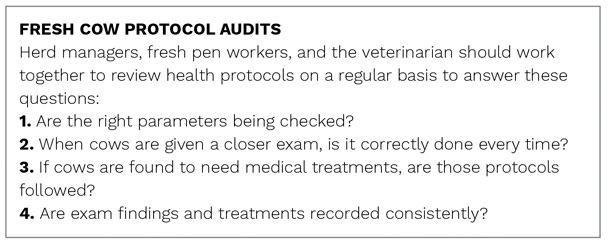
Another recent advancement is the incorporation of automated activity and rumination monitoring system alerts into fresh cow management programs. Research from Dr. Julio Giordano’s lab shows that these automated health monitoring systems (AHMS) can identify some common fresh cow health disorders sooner than our traditional methods without disturbing the cows. Research published in 2016 showed AHMS had a sensitivity of greater than 90 percent for finding cows with a DA or ketosis and identified cows with these disorders on average about two days before the farms’ conventional protocol.
Recently completed research compared a health monitoring program based primarily on AHMS to a conventional monitoring protocol and found no real differences in the outcomes of interest - milk production, milk quality, early removal from the herd, first service estrus detection rate or fertility. These automated systems do not take away our need to keep an eye on these special needs animals, but by combining this data with visual assessments and production information from the parlor, fresh cow managers can efficiently monitor their fresh cows while minimizing the time cows are kept from their regular behavior.
Parlor or robotic milking data (yield, color, consistency, components) can help track the progress and health of the early lactation cow. Someone trained in reviewing this specialized information should be sharing parlor/robot reports with the rest of the fresh cow team in a timely manner.
Pen observations
Proper stall dimensions, bedding quantity, and cleanliness are important across the dairy, but they are critical to the success of fresh cows. Overcrowding can be particularly detrimental in the fresh pen. By calculating stocking density (at least for headlocks) each month, managers will better understand how fluctuations in pen counts may affect the success of fresh cows.
Body condition scores (BCS) can be a good tool to use when troubleshooting. We really want consistency across the board in our fresh cow BCS. Cows coming in too heavy may have metabolic issues, but too thin may have a hard time keeping up with energy needs.
The key is to minimize too much change in BCS. What do the inhabitants of your fresh pen look like as a whole, and how long has each cow been in that pen? As cows progress into peak lactation, they change as well. Knowing who is in the pen and their days in milk (DIM) can help troubleshoot issues in the fresh pen.
When locking cows, is the time limited to just what’s necessary to get the job done? Are other cows getting locked up unnecessarily, like high-producing cows in the pen just waiting for their milk residue to clear before heading back to their home pen? Are we also capturing our treated mastitis cow that is heading back to high-producing?
What can the feedbunk tell us?
One of the goals of fresh cow nutrition is to minimize negative energy balance (NEB) to prevent or lower the negative impacts of ketosis. The nutritionist should have the fresh cow diet well-balanced for the nutrients needed by fresh cows and complimentary to the dry cow diet. A look at the bunk after cows have eaten provides valuable insight. If cows are leaving a lot of long particles, they are likely sorting for the concentrate. A Penn State particle separator will help check for proper TMR mixing and particle length.
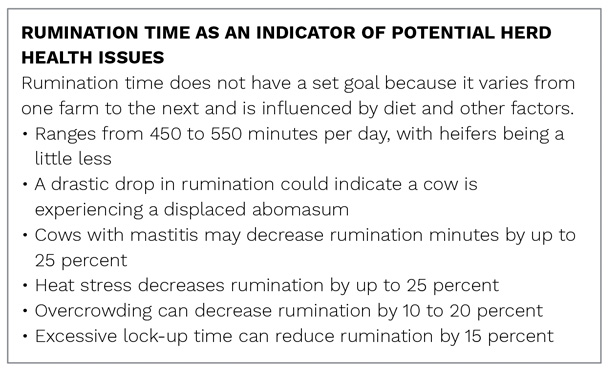
Perhaps mixing order or time need to be adjusted, or theoretical length of cut changed at next harvest. Sometimes cows will sort for longer particles to self-regulate when their stomachs are upset. If available, they will also consume higher amounts of bicarb. Periodic manure scoring and screening can help evaluate feed processing and digestion. Manure that is too stiff or excessively dry could indicate that the cows are getting too much fiber or not enough water. Inconsistency between manure piles within a pen may indicate inappropriate sorting behavior or inadequate bunk space per cow.
Dry period impact on fresh cows
The root cause of some fresh cow health issues might be prefresh management practices or environmental conditions. For example, heat stress during the dry period can impair lactation performance. Research from University of Florida – Gainesville shows that dry cows provided with supplemental cooling produced an additional 11 pounds of milk per day throughout the next lactation when compared to their herdmates not cooled. (Figure 1), and calves born from cows provided supplemental cooling during their dry period performed better.
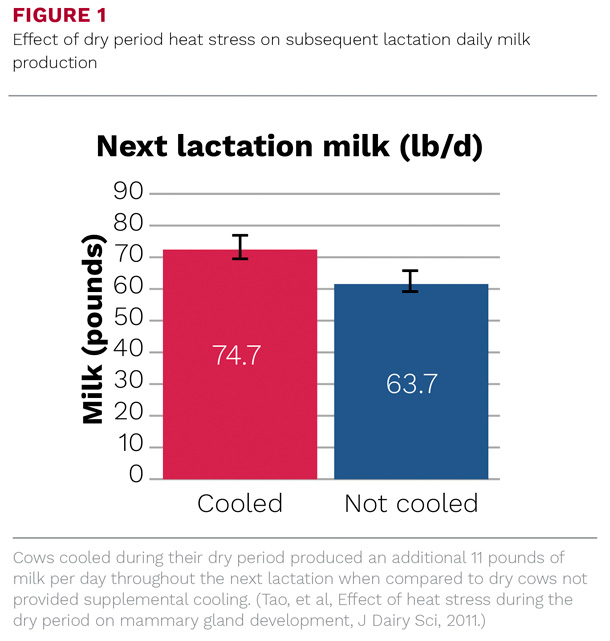
There is good reason to take another look at the farm’s heat abatement strategies.
To hear more about troubleshooting fresh cow health or other dairy management topics, visit the Pro-Dairy website podcast page.
This article appeared in Pro-dairy’s The Manager in July 2021. To learn more, visit Pro-Dairy Cornell CALS.
